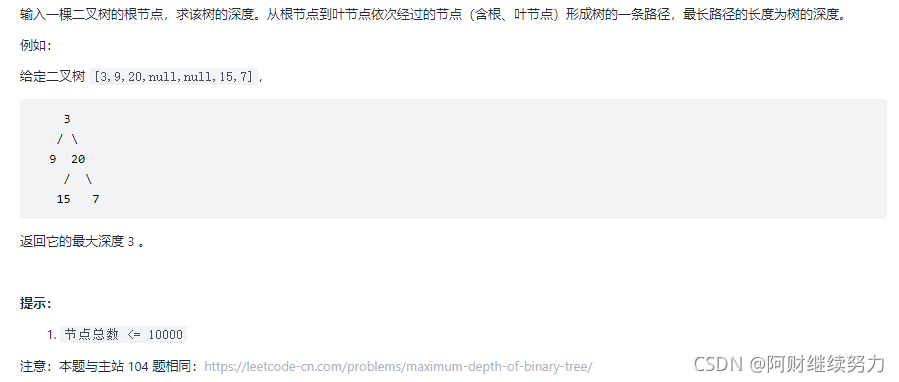1. 题目

2. 思路
(1) 深度优先搜索
- 利用curDepth记录当前所在层数,maxDepth记录到达过的最大层数。
- 每到达一个非空结点,curDepth加1,并更新maxDepth,然后遍历左右子树,最后返回上一层时,curDepth减1。
(2) 深度优先搜索优化
- 每一个结点的深度可以看做左右子树中最大深度加1,利用递归实现。
(3) 广度优先搜索
- 利用队列实现广度优先搜索,每到达一层,依次弹出队列中这一层的结点,然后加入下一层的结点,最后result+1。
- 当队列为空时,表示搜索完毕,返回result即可。
3. 代码
import java.util.LinkedList;
import java.util.Queue;
public class Test {
public static void main(String[] args) {
}
}
class TreeNode {
int val;
TreeNode left;
TreeNode right;
TreeNode(int x) {
val = x;
}
}
class Solution {
private int curDepth = 0;
private int maxDepth = 0;
public int maxDepth(TreeNode root) {
if (root == null) {
return 0;
}
dfs(root);
return maxDepth;
}
private void dfs(TreeNode root) {
if (root == null) {
return;
}
if (++curDepth > maxDepth) {
maxDepth = curDepth;
}
dfs(root.left);
dfs(root.right);
curDepth--;
}
}
class Solution1 {
public int maxDepth(TreeNode root) {
if (root == null) {
return 0;
}
return Math.max(maxDepth(root.left), maxDepth(root.right)) + 1;
}
}
class Solution2 {
public int maxDepth(TreeNode root) {
if (root == null) {
return 0;
}
Queue<TreeNode> queue = new LinkedList<>();
queue.add(root);
int result = 0;
while (!queue.isEmpty()) {
int size = queue.size();
for (int i = 0; i < size; i++) {
TreeNode node = queue.poll();
if (node.left != null) {
queue.offer(node.left);
}
if (node.right != null) {
queue.offer(node.right);
}
}
result++;
}
return result;
}
}

























 8748
8748

 被折叠的 条评论
为什么被折叠?
被折叠的 条评论
为什么被折叠?








